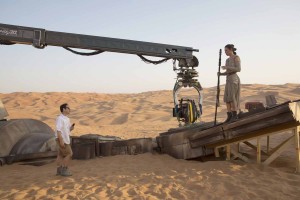
Starring newcomers to the film series Daisy Ridley as Rey, John Boyega as Finn, Oscar Isaac as Poe Dameron, Adam Driver as Kylo Ren and Domnhall Gleeson as General Hux, Abrams’ piece also included stalwarts from the original 1977-1983 trilogy of films, famously Harrison Ford as Han Solo, Carrie Fisher as General Leia and Mark Hamill as Luke Skywalker, among creature performers such as Anthony Daniels as droid C-3PO and Peter Mayhew as Solo’s humanoid partner, Chewbacca. The mix of old and new has seemingly intrigued fans who have been intensely curious about the return to the spiritual territory of the early films while remaining hungry for fresh plot lines, settings and characters.
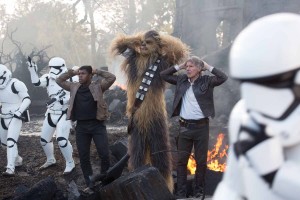
When Abrams first agreed to direct the film, and after fashioning a screenplay first with screenwriter Michael Arndt and later with Star Wars’ veteran Lawrence Kasdan, Abrams met with his key collaborators to devise a plan for bringing Star Wars into the 21st century. “It’s the process you would imagine,” Abrams stated of his first meetings with his craftspeople on The Force Awakens. “Sitting down with everyone and having conversations about intention and finding the best way to accomplish the goals, and all of the technical aspects that are required. It was 10 million baby steps with everyone doing the best job I’ve ever seen.”
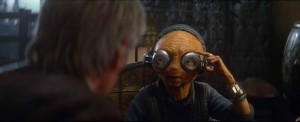 To find the aforementioned young talent for the film’s new roles, most of whom were relative unknowns in feature films, Abrams utilized a team of “amazing” casting directors in the United Kingdom – Nina Gold, April Webster and Alyssa Weisberg. “We saw a crazy number of different actors,” Abrams noted. “Some were fantastic. Daisy and John, Oscar, Adam, there was something about this particular group that was undeniable. Oscar or Adam, some people may recognize them, but they were not as widely known as they could have been. Daisy and John were essentially unknown – brand new to the audience. A fun piece of casting.”
To find the aforementioned young talent for the film’s new roles, most of whom were relative unknowns in feature films, Abrams utilized a team of “amazing” casting directors in the United Kingdom – Nina Gold, April Webster and Alyssa Weisberg. “We saw a crazy number of different actors,” Abrams noted. “Some were fantastic. Daisy and John, Oscar, Adam, there was something about this particular group that was undeniable. Oscar or Adam, some people may recognize them, but they were not as widely known as they could have been. Daisy and John were essentially unknown – brand new to the audience. A fun piece of casting.”
Another one of his first and most crucial discussions occurred in concert with cinematographer Daniel Mindel who also shot Abrams’ two Star Trek films. “With Dan,” Abrams explained of his valuable conversations with his DP, “we discussed what lens package we were looking for to get the look we were after. This was a critical thing for me, that the movie look and feel captured in camera and as authentic as possible. From props to set design and builds to locations, to shooting and lighting, creatures, droids, it all needed to feel like it exists – tangible, tactile and real.”
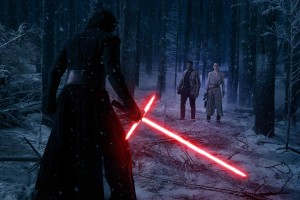 In realizing Star Wars’ pivotal look in distant planets, spaceships and exotic locales, in addition to working with Mindel, Abrams recruited production designer Rick Carter, notable for his award-winning work on a horde of Steven Spielberg’s genre blockbusters since Jurassic Park. “There was no template,” Abrams revealed about his liaison with Carter. “I asked Rick Carter to begin much earlier than a production designer normally would — at the story stage — partly because Rick is a dreamer, and I think of him as a ‘connectician.’ He connects things that I don’t see anyone else do, between little moments and the big pictures. I had him with Arndt and Kasdan to be a counterweight to the grind of breaking the story. Rick would seize an idea that was mentioned, bring up one of his own, and, early on, draw up ideas based on things that we were discussing. It became this evolutionary iterative process. It would give us a sense of where it might take place and the result. It was a helpful visual means of development.”
In realizing Star Wars’ pivotal look in distant planets, spaceships and exotic locales, in addition to working with Mindel, Abrams recruited production designer Rick Carter, notable for his award-winning work on a horde of Steven Spielberg’s genre blockbusters since Jurassic Park. “There was no template,” Abrams revealed about his liaison with Carter. “I asked Rick Carter to begin much earlier than a production designer normally would — at the story stage — partly because Rick is a dreamer, and I think of him as a ‘connectician.’ He connects things that I don’t see anyone else do, between little moments and the big pictures. I had him with Arndt and Kasdan to be a counterweight to the grind of breaking the story. Rick would seize an idea that was mentioned, bring up one of his own, and, early on, draw up ideas based on things that we were discussing. It became this evolutionary iterative process. It would give us a sense of where it might take place and the result. It was a helpful visual means of development.”
Also on board as production designer was Darren Guilford who led operations from the Pinewood Studios base of the film. “Darren came on fairly early, but not as early as Rick,” Abrams explained. “He was on the ground full-time in London; Rick would come and go. He was hungry, brilliant, wonderfully collaborative. Rick was the lead, but Darren was often the person I was dealing with.”
 Also integrally involved in developing the world of Star Wars: The Force Awakens was visual effects supervisor Roger Guyett who had worked in the same capacity on Abrams’ two Star Trek films and would oversee more than 2,000 visual effects shots on the new film. “Having worked with Roger a few times before, we have a shorthand and a very easy working relationship that makes the hard work fun,” Abrams conveyed. “We would often talk early on about how we were going to approach certain things, breaking it down into pieces, even shots themselves, and asking, ‘What are the elements that are needed?’”
Also integrally involved in developing the world of Star Wars: The Force Awakens was visual effects supervisor Roger Guyett who had worked in the same capacity on Abrams’ two Star Trek films and would oversee more than 2,000 visual effects shots on the new film. “Having worked with Roger a few times before, we have a shorthand and a very easy working relationship that makes the hard work fun,” Abrams conveyed. “We would often talk early on about how we were going to approach certain things, breaking it down into pieces, even shots themselves, and asking, ‘What are the elements that are needed?’”
With a visual effects-intensive film, the worry of many a filmmaker is that the project becomes drenched in technical production in lieu of story and character, but Abrams knew he had a wholly narrative collaborator in Guyett. “The wonderful thing about working with Roger is he’s very much a storyteller,” Abrams explained. “He goes beyond in every situation: what is necessary into what is better. We would keep iterating shots, sequences and moments as we went along. The number of visual effects was always something we knew we would have to deal with.”
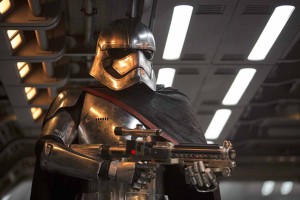 Though many of the visual effects elements in Star Wars: The Force Awakens included set extensions plus removing rigs and puppeteers inadvertently captured during principal photography, one key visual effects task on the film regarded realizing an important character. “Maz Kanata, we re-wrote, re-shot to get it right,” Abrams explained of a diminutive character voiced by Lupita Nyong’o who provides sage advice to the film’s heroes. “Lupita brings to the part what we wanted – different approaches to different scenes, and Maz really came alive. I saw all the work, the amount of effort that went into bringing her to the screen.”
Though many of the visual effects elements in Star Wars: The Force Awakens included set extensions plus removing rigs and puppeteers inadvertently captured during principal photography, one key visual effects task on the film regarded realizing an important character. “Maz Kanata, we re-wrote, re-shot to get it right,” Abrams explained of a diminutive character voiced by Lupita Nyong’o who provides sage advice to the film’s heroes. “Lupita brings to the part what we wanted – different approaches to different scenes, and Maz really came alive. I saw all the work, the amount of effort that went into bringing her to the screen.”
Throughout principal photography, based at Pinewood Studios and for another year of postproduction at Bad Robot, Abrams crafted the film with his two longtime editors, Maryann Brandon and Mary Jo Markey. “I’ve worked with them for quite a while,” said Abrams. “The approach is always the same. We’re all at the service of the characters and the story. They split up the film in very large chunks. There was parallel work being done in different sequences.”
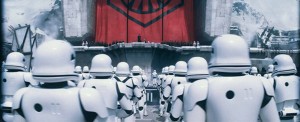 Somewhat non-traditionally, Brandon and Markey each worked on their own specified section of the film, later weaving them together with Abrams into one complete project. During this period, the two editors would regularly view each other’s work. “There was an instructive and friendly competition between the two editors,” said Abrams. “They each wanted their sequence to blow away the other’s. They are each working to do something that now will be seen by a fellow editor. It’s always fun working on a sequence and sharing with the other for notes and point-of-view. It raises the conversation. It goes on longer than you would expect. It could be a recut or reshoot. I have two partners in crime who are always focused on the right thing – telling the story.”
Somewhat non-traditionally, Brandon and Markey each worked on their own specified section of the film, later weaving them together with Abrams into one complete project. During this period, the two editors would regularly view each other’s work. “There was an instructive and friendly competition between the two editors,” said Abrams. “They each wanted their sequence to blow away the other’s. They are each working to do something that now will be seen by a fellow editor. It’s always fun working on a sequence and sharing with the other for notes and point-of-view. It raises the conversation. It goes on longer than you would expect. It could be a recut or reshoot. I have two partners in crime who are always focused on the right thing – telling the story.”
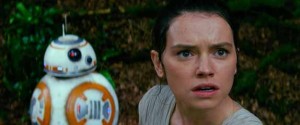 In hindsight, with the news of Star Wars: The Force Awakens breaking Avatar’s domestic box office record first coming to light, Abrams was reflective about his place in this unique cinematic domain, now almost 40-years-old. “The opportunity to play in this incredible universe that George built is a dream come true, and a pretty incredible opportunity and experience. I’m nothing but grateful for it,” Abrams said. “We all wanted to have fun with the movie and feel the possibility that I felt when I was a kid. With this cast, it’s something that I’m really proud to be associated with – a movie that lets kids of color and little girls see that there isn’t a corner of the universe where they aren’t valued and needed. To get to do that in a Star Wars universe is really exciting. Families are going to see this movie. People are going back with their parents. For new fans and people who are going back in time. It’s so much fun to be a part of something that seems to be something that people want – a return to that place that George created with new characters.”
In hindsight, with the news of Star Wars: The Force Awakens breaking Avatar’s domestic box office record first coming to light, Abrams was reflective about his place in this unique cinematic domain, now almost 40-years-old. “The opportunity to play in this incredible universe that George built is a dream come true, and a pretty incredible opportunity and experience. I’m nothing but grateful for it,” Abrams said. “We all wanted to have fun with the movie and feel the possibility that I felt when I was a kid. With this cast, it’s something that I’m really proud to be associated with – a movie that lets kids of color and little girls see that there isn’t a corner of the universe where they aren’t valued and needed. To get to do that in a Star Wars universe is really exciting. Families are going to see this movie. People are going back with their parents. For new fans and people who are going back in time. It’s so much fun to be a part of something that seems to be something that people want – a return to that place that George created with new characters.”
Humbly, Abrams concluded with a measured outlook on his film’s meteoric and undeniably phenomenal success. “I feel nothing but relief that the movie is out and where it belongs – with the fans.”





